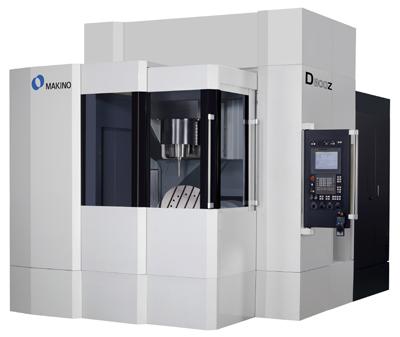
Makino introduces the newest addition to its family of 5-axis vertical machining centers, the D800Z. Joining the Makino D-Series (D300 and D500), the D800Z is designed for high-performance job shops, precision parts machining, die/mold and aerospace applications. Like the other two D-Series machines, the D800Z offers easy access to the spindle and table, a highly rigid structure for responsive cutting, outstanding surface finishes and optional automation devices. Workpieces of up to 1,000mm in diameter and 1,200kg in weight can be machined in five axes, with great efficiency and fewer operations for reduced production time.
"Large-part 5-axis machining presents numerous challenges, due to the size, weight and range of features found on large components," said Bill Howard, VMC product line manager at Makino. "The D800Z 5-axis machine provides new levels of sustained dynamic accuracy, achieved through technologies that are very productive, yet minimize thermal influences and maximize volumetric accuracy."
The 5-axis capability of the D800Z can be utilized in five-face milling mode to minimize setup, maximizing access to complex, multisided parts and reducing cycle times, or to address the demanding angular, blending, matching, fine-surface finishes and 3-D accuracy requirements of die-and-mold components. The integral, direct-drive motor design of the fourth and fifth axes and highly rigid supporting machine structure deliver productive speed and smooth motion, and ensure outstanding accuracy—even with large workpieces and payloads up to 1,200kg. In addition, core-cooled ballscrews, temperature control of the direct-drive motors and massive machine structure provide renowned thermal stability that guarantees sustained accuracy over time.
The uniquely designed "Z" shape of the tilt-trunnion table ensures that the center of gravity of the table and work are always captured within the center of rotation of the B- and C-axes. Large-diameter bearings minimize table deflection and provide outstanding stiffness and rigidity, regardless of the angular and rotary position of the work. The direct-drive motor design provides the speed for productivity and precision for tight-tolerance work.
The D800Z can be configured with two different spindle combinations: D800Z (#40) and D800Z (#50). The D800Z (#40) offers a standard Cat #40 (or optional HSK-A63) 14,000-rpm spindle. As an option, the D800Z (#40) can also be configured with a 20,000-rpm HSK-A63 spindle. The D800Z (#40) incorporates a 40-tool magazine. The D800Z (#50) offers a standard Cat #50 (or optional HSK-A100) 12,000-rpm spindle. As an option, the D800Z (#50) can also be configured with an 18,000-rpm HSK-A100 spindle. The D800Z (#50) incorporates a 48-tool magazine. The range of spindle offerings provides the ability to customize the machine to suit a wide variety of machining applications. Feed rates of 36,000mm/min. on the X-, Y- and Z-axes, and 18,000 deg/min. (50 rpm) on the B- and X-axes ensure productivity.
Also featured on the D800Z is Makino's proprietary, next-generation Super Geometric Intelligence (SGI.4) software developed specifically for high-feed rate, tight-tolerance machining of complex 3-D, contoured shapes involving continuous tiny blocks of NC data, which ensures production rates faster than standard CNC systems, while maintaining high accuracy. SGI.4 helps provide the lowest cycle times and costs achievable by reducing machining cycle times on dies, complex cavities and cores, and aerospace parts by as much as 40 percent, when compared to most other control technologies.
The D800Z is equipped with a number of 5-axis features, including Tool Center Point (TCP) control, which permits programming based on the tool tip, so that tool compensation features can be applied. Further TCP developments improve the cutter path to achieve greater surface quality. Dedicated user-friendly screens are developed to simplify the overall application of 5-axis machining. Easy-to-apply functions are included to prevent interference between the spindle and trunnion during automatic operation, eliminating collisions.
The D800Z comes with a two-sided front-door design, for easy access to the spindle and table for setup purposes, and a large window, for enhanced visibility. The machine's compact size of 3,200mm x 5,070mm x 3,600mm requires less floor space, and its intelligent design facilitates maintenance activities. The D800Z has also been designed to lower a shop's operating costs through reduced energy consumption. To save energy costs, the D800Z features an eco mode, which turns off peripheral devices when they are not needed. The energy-saving coolant system comes with an inverter-driven coolant pump that supplies precisely the required flow rate and timing for each function. The hydraulic unit, with its accumulator, ensures zero power consumption when the pump is idle.
Contact Details
Related Glossary Terms
- 3-D
3-D
Way of displaying real-world objects in a natural way by showing depth, height and width. This system uses the X, Y and Z axes.
- centers
centers
Cone-shaped pins that support a workpiece by one or two ends during machining. The centers fit into holes drilled in the workpiece ends. Centers that turn with the workpiece are called “live” centers; those that do not are called “dead” centers.
- computer numerical control ( CNC)
computer numerical control ( CNC)
Microprocessor-based controller dedicated to a machine tool that permits the creation or modification of parts. Programmed numerical control activates the machine’s servos and spindle drives and controls the various machining operations. See DNC, direct numerical control; NC, numerical control.
- coolant
coolant
Fluid that reduces temperature buildup at the tool/workpiece interface during machining. Normally takes the form of a liquid such as soluble or chemical mixtures (semisynthetic, synthetic) but can be pressurized air or other gas. Because of water’s ability to absorb great quantities of heat, it is widely used as a coolant and vehicle for various cutting compounds, with the water-to-compound ratio varying with the machining task. See cutting fluid; semisynthetic cutting fluid; soluble-oil cutting fluid; synthetic cutting fluid.
- feed
feed
Rate of change of position of the tool as a whole, relative to the workpiece while cutting.
- gang cutting ( milling)
gang cutting ( milling)
Machining with several cutters mounted on a single arbor, generally for simultaneous cutting.
- milling
milling
Machining operation in which metal or other material is removed by applying power to a rotating cutter. In vertical milling, the cutting tool is mounted vertically on the spindle. In horizontal milling, the cutting tool is mounted horizontally, either directly on the spindle or on an arbor. Horizontal milling is further broken down into conventional milling, where the cutter rotates opposite the direction of feed, or “up” into the workpiece; and climb milling, where the cutter rotates in the direction of feed, or “down” into the workpiece. Milling operations include plane or surface milling, endmilling, facemilling, angle milling, form milling and profiling.
- numerical control ( NC)
numerical control ( NC)
Any controlled equipment that allows an operator to program its movement by entering a series of coded numbers and symbols. See CNC, computer numerical control; DNC, direct numerical control.
- stiffness
stiffness
1. Ability of a material or part to resist elastic deflection. 2. The rate of stress with respect to strain; the greater the stress required to produce a given strain, the stiffer the material is said to be. See dynamic stiffness; static stiffness.
- toolpath( cutter path)
toolpath( cutter path)
2-D or 3-D path generated by program code or a CAM system and followed by tool when machining a part.

